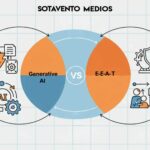The age of artificial intelligence is transforming the business world. 92% of C-suite executives plan to deploy AI automation by 2026. Companies that don’t have a clear plan regarding AI can lose the race. To use AI well, businesses need a complete internal strategy for growth and success.
Understanding the Need for an AI Strategy
AI is more than new gadgets; it changes how businesses operate, make decisions and help customers.
The reason is that most companies approach AI as a tool instead of a strategy. A successful AI application implies aligning the technology with clear business objectives, processes and the company’s culture.
A clear AI strategy helps a company select projects that increase productivity, improve decision-making and generate more profits. Creating an AI strategy inside your company is a big opportunity for companies that think about growth in the future. But it works only if you plan well and make sure that all the elements in the plan fit with one another and put real business before fancy trends. According to latest reports, 83% business owners believe that AI has been a top priority for their business growth.
The key to any successful strategy is a clear goal, a safe foundation and measurable outcomes while keeping track of real-life business value. Using this plan, companies can implement AI completely without suffering from the common errors. The world of AI is fast evolving. Those with concrete plans in mind can exploit new opportunities at a faster rate and get ahead. It’s time to plan for AI – the future is smart workplaces.
Companies with developed AI plans see big results, with high performers saying more than 10% of their profit growth comes from AI.
Building Your AI Strategy Framework
Step 1: Clarifying Vision and Business Alignment
Every successful AI strategy begins with a vision that aligns with your overall business plan. AI should be connected to higher business objectives from both the top and bottom management- not as isolated initiatives. Aligning your main priorities to specific AI fields like customer service, marketing or supply chain and listening to the people who will be using AI daily to gain a better understanding of real problems and challenges.
Step 2: Evaluate Current State and Data Readiness
AI can only be as good as the data being used. Before you begin, check your data system carefully. Good, clean data is the foundation of every successful AI project. Examine data storage, data quality and consistency, and determine if data can be used for AI. Put in place clear rules for data, standards formats, privacy policies and ownership. This foundation guarantees the reliability of AI and the elimination of the probability of poor outcomes.
Step 3: Identify Use Cases That are High Impact
Not all artificial intelligence projects carry the same benefits. Pick cases where AI can really help- improving efficiency, customer service or processes. Prioritize projects based on the following factors: Guaranteed business results, adequate quality information for training, technical feasibility and scalability across business functions. Additionally, pick easy, repeatable processes with well-defined input and processor outputs, such as document processing, customer inquiry triage or preventive maintenance scheduling.
Step 4: Make an Implementation Plan for AI
Make a simple 3-step plan for using AI:
- Wave 1(Getting Things Done): Use AI to do regular tasks faster and more efficiently.
- Wave 2(Better Quality): Use AI to provide better insights and predict outcomes for better decision-making.
- Wave 3(New Systems): Use powerful AI to develop new ways of doing business and let the system run itself.
This step-by-step solution gives companies experience, proven results, scalable growth for successful projects and controlled risk and resources.
Addressing Implementation Challenges
Solving Problems with Technical Integration
Integrating AI with existing systems is a big hurdle. Older systems can’t even work with new AI solutions. Successful integration requires:
- Evaluate the current infrastructure to identify gaps
- Develop a suitable plan for cloud migration.
- Develop very well documented APIs for inter-system connectivity.
- Roll out changes slowly to minimize disruption
Work with experienced firms in artificial intelligence development to ensure a seamless integration that is cost-effective and provides on time delivery.
Managing Change and Workforce Transition
Organizational change management is important when implementing AI. Ease your employees’ fears by framing AI as an augmenting tool that enhances employee work rather than a replacement for them. Invest in upskilling and reskilling programs to help teams work with AI systems. Teach your staff how to work with AI and to use it to solve problems in a creative (not automated) manner. This makes resistance go down and collaboration between human skills and AI capabilities rise.
The Ethics of Implementing Artificial Intelligence
Develop AI governance frameworks that include considering ethical issues at the initial stage. Set clear policies covering:
- Algorithmic transparency & explainability
- Identification of and correction of bias
- Data privacy/data security protocols
- Human interference in important decisions
Strong governance allows execution of SEO strategies by building trust with stakeholders and mandatory adherence to changing regulations.
Measuring AI Success and ROI
Establishing Comprehensive Metrics
AI needs to be re-evaluated from simple cost-savings to a strategic value proposition to determine how AI improves ROI. For measuring, four major components are used:
Efficiency and Productivity: Check the task volume that is being automated and the time saved from it.
Revenue Growth: Track how AI has helped to fuel sales, retain customers and identify new market opportunities
Risk Mitigation: Measure security, rules compliance & reliable operations
Business Agility: Evaluate how quickly the business can make its decisions, how well it correlates to the market and how well it stands among its rivals.
Implementing the Tracking Infrastructure
Among all the support modules built for AI, the most critical ones are creating dashboards to keep track of the performance of your AI in different operations. Employ an ERP system to directly measure financial metrics, use business intelligence software for visual charts, and AIOps tools to evaluate the health of the system. Taking this holistic approach keeps people accountable and provides ideas for continuous improvement.
Attract Stakeholders
Communicate AI ROI by exploring cohesive, relatable success stories with sales and measurable success stories your executives can relate to. Data-driven storytelling helps support and build the case for how AI initiatives are helping deliver real-world business outcomes that will make a great impression on those who will continue to invest.
Leadership and Long-Term Acquisition
Developing the AI Governance Structure
With the goal of being successful in AI governance, one should have a clear leader and organization. So set up roles like:
- Chief AI officers or a governance committee
- Project Managers
- Data stewards
- Ethics officers
This structure serves as a means to hold people accountable and align all AI initiatives as well.
Continuous Optimization and Scaling
AI strategy must constantly improve. Put in place monitoring through which you can watch model performance – find problems and indicate where improvement is needed. This regular audit section will keep you in compliance and help you check whether your models are performing well or not. Moreover, right from the beginning, consider scaling so that you can develop a strategy and systems that can grow with your business and stay fast and secure. This future-proof approach maximizes long-term value and minimizes technical debt in the future.
Want to create an AI strategy? Leverage Digital Marketing leaders who are well-versed in the latest technologies and business tactics. Reach out to us instantly to discover how we can transform your business operations using intelligent AI and help you bring measurable growth in 2025 and beyond.










